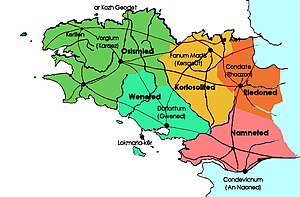Osismii


The Osismii were a Gaulish tribe on the western Armorican peninsula.[1] They were first described as the Ostimioi by the Greek geographer and traveller Pytheas in the fourth century BC.
He situated them at the end of the peninsula of Kabaïon, which is not clearly identifiable today (this could be related to large peninsula of Cap-Sizun, on the southern-western coast of Finistère, just before reaching the difficult maritime pass of Pointe du Raz where the waters of the Atlantic Ocean and of the English channel are joining; this peninsula offers to the south a natural safe harbour in the aber and bay of today's town of Audierne, as well as in the bay of today's Douarnenez, to the north of the peninsula; the other capes of peninsulas in Finistère are easier to navigate ; other hypotheses situate it in the small peninsula of Kermorvan in today's commune of Ploumoguer and bordering the ria of Le Conquet, but the whole peninsula of Crozon with its large bays and safe harbors is not excluded, even if it does not extend to the westernmost point).
Their name (Ostimioi) means "the farthest" or "those at the end of the world". Their territory corresponded broadly to the modern French département of Finistère, whose name reflects the same meaning in Latin Finis Terræ, i.e. end of the earth. Their chief city was Vorgium, modern Carhaix (in today's commune of Carhaix-Plouguer).
They survived into Roman times and are found in the texts of Julius Caesar, Pliny the Elder, and Strabo.[2] They submitted to Caesar during the Gallic Wars, in 57 BC. The next year, they revolted along with the Veneti, but were put down. They became a Roman civitas and their identity survived into Late Antiquity.
Sources
- Smith, Julia M. H. Province and Empire: Brittany and the Carolingians. Cambridge: Cambridge University Press, 1992.
References
- ^ Galliou, P., R. Talbert, S. Gillies, T. Elliott, J. Becker. "Places: 69547 (Osismii)". Pleiades. Retrieved December 30, 2015.
{{cite web}}: CS1 maint: multiple names: authors list (link) - ^ Strabo 4.4.1

